Art & Exhibitions
Can Damien Hirst’s $38 Million London Museum Resuscitate His Waning Market?
We take a close look at Newport Street Gallery.

Photo: Prudence Cuming © Kioyar Ltd.
We take a close look at Newport Street Gallery.

Lorena Muñoz-Alonso

Today, Damien Hirst’s £25 million ($38 million) London museum is opening its doors to the public. Newport Street Gallery is a 37,000 square feet temple that Hirst has dedicated to his 3,000-work art collection, which has the rather YBA-esque name of Murderme.
News of the imminent launch of Hirst’s entirely self-funded museum was received last spring with much suspicion and many a raised eyebrow. Artists don’t usually build personal museums (with some exceptions); traditionally, it’s the prerogative of wealthy collectors and benefactors.
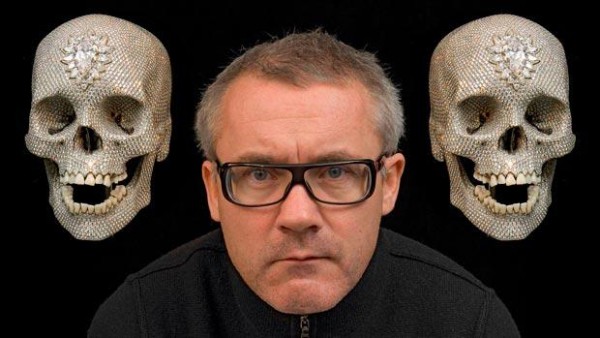
Damien Hirst.
Photo: Phaidon.com.
It didn’t help matters that Hirst’s market has been going steadily downhill since his Sotheby’s coup in 2008, where he broke all art rules and bypassed his dealers by selling works directly through auction, reaping a whopping £115.5 million ($177 million) profit in the process.
Things were never the same for his market after that move, considered downright outrageous by most art world players. “None of us intended to devalue his market, but suddenly after that sale the luster of Damien Hirst was gone,” Oliver Barker, deputy chairman of Sotheby’s Europe, told the Wall Street Journal.
In light of this, many have wondered whether Newport Street Gallery might in fact be Hirst’s strategy to revitalize his waning market, or, at least jumpstart the value of his art collection (possibly even both?).
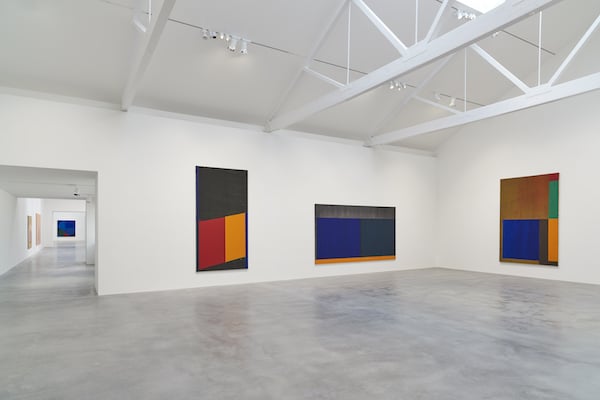
Installation view of John Hoyland’s “Power Stations” at Newport Street Gallery.
Photo: Prudence Cuming Associates © Kioyar Ltd.
According to Hirst’s team, however, Newport Street Gallery’s premise is quite simple and idealistic: To open a free-admission space for his collection.
Kate Davies, head of the Murderme collection, told artnet News that there’s no Machiavellian masterplan behind it. “It’s been a long ambition of Damien’s to share his collection with the public. He is an avid collector and curator and has been building Murderme since the late 1980s, around the time he curated Freeze in 1988,” she explained.
“He’s said that he was really inspired by Charles Saatchi’s Boundary Road gallery, which he went to many times as a young artist,” she added. (The press blurb also explains that, because admission is free, Hirst hopes to be able to offer the younger generation the possibility of returning many times to really get to know Hoyland’s work.)
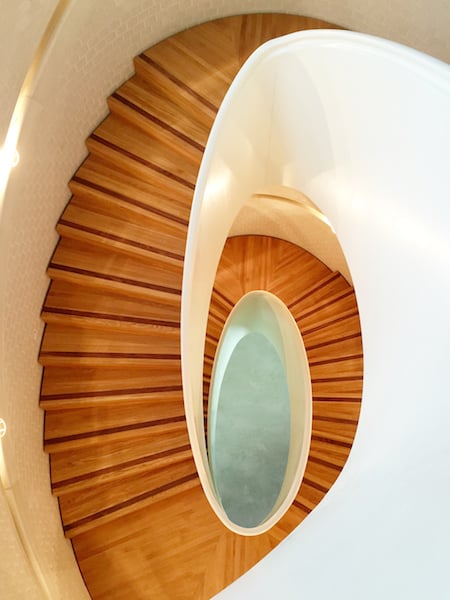
Stairwell at Newport Street Gallery in London.
Photo: © Kioyar Ltd.
But, what’s the museum itself like?
Well, in terms of architecture at least, the museum is certainly a triumph. Perhaps one of the best contemporary art exhibition spaces that London has welcomed since the launch of Raven Row in 2009. Designed by the architects Caruso St John, Newport Street Gallery is indeed a successfully designed temple dedicated to art. Its impossibly tall ceilings with skylights, white walls, sleek polished concrete floors, and three stunning oval staircases make it into a space that invites the viewer to stay, and to contemplate.
It’s also massive; an ambitious complex that also hosts a shop selling books and editions and, launching next year, a restaurant: Pharmacy2, marking Hirst’s return to the hospitality business (the first Pharmacy was an award winning restaurant and celebrity hotspot in Notting Hill, which Hirst operated in London between 1998 and 2003).
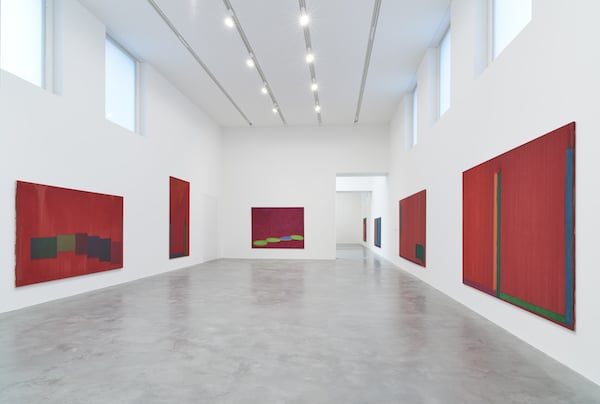
Installation view of John Hoyland’s “Power Stations” at Newport Street Gallery.
Photo: Prudence Cuming Associates © Kioyar Ltd.
Inside that beautiful vessel hangs a solo exhibition dedicated to the British abstract painter John Hoyland (1934-2011), who was, according to Hirst, an artist’s artist and “one of the greatest British abstract painters.”
Critics have disagreed. Despite having had shows at the Whitechapel Gallery (1967), the Serpentine Gallery (1979), and the Royal Academy of Arts (1999) in his heyday, Hoyland has been called “a second rate artist, mediocre, and justly forgotten” by the Guardian’s Jonathan Jones, who wasn’t mincing his words as per usual. Jones also said Hoyland’s paintings are “art studentish attempts to knock out a [Mark] Rothko, a [Jackson] Pollock, or a Barnett Newman.”
Even if I disagree with Jones’s raging scorn, it’s obvious that the British painter was in awe of the painters of the so-called New York School (Robert Motherwell, though, seems a more pressing influence here than Pollock).
Hirst began collecting Hoyland’s work in 2009, when the two artists became friends two years before Hoyland’s death. But it hadn’t always been so chummy between the two artists. In fact, Hoyland wasn’t a fan of Hirst and his YBA fellows to begin with.
According to the Financial Times, at his last show in London in 1999, Hoyland said that Hirst was “becoming an entrepreneur. Artists should not farm their work out” and that he didn’t think that “you make great art unless you paint it yourself,” probably referring to the horde of employees Hirst pays to churn out his butterfly and dot paintings.
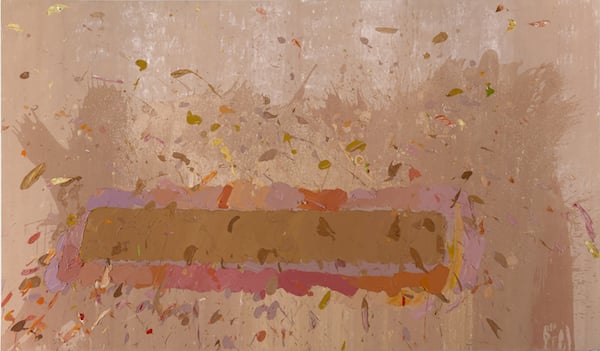
John Hoyland, 28.2.71.
Photo: Prudence Cuming Associates © The John Hoyland Estate.
Despite the patchy start, the two artists eventually realized they had in common more than they initially thought, and now, Newport Street Gallery’s inaugural exhibition, entitled “Power Stations,” features 33 large-scale canvases by Hoyland, all owned by Hirst. My favorites are not the ones in red palettes he painted through the 60s, which dominate the ground floor, but the later ones, installed on the second floor, painted in the 70s in various hues of pinks. They are more textured, featuring heavier impastos and more expressive brushstrokes, and are, for me at least, more convincing and interesting.
Lovers of this meditative brand of abstract painting will find “Power Stations” enticing, and Hoyland’s canvases are certainly flattered by the stunning architecture, bathed in natural light. Those who aren’t particularly moved by this style will have to wait six months for the next exhibition, whose details haven’t been announced yet.
Murderme, however, has a generous selection of works by blockbuster artists—including Pablo Picasso, Andy Warhol, Francis Bacon, Jeff Koons, and Richard Prince, as well as a bunch of artworks by Hirst’s peers, Sarah Lucas in particular (the only member of the group whose critical and commercial reputation has managed to survive the YBA hangover)—so there’s room for hope.
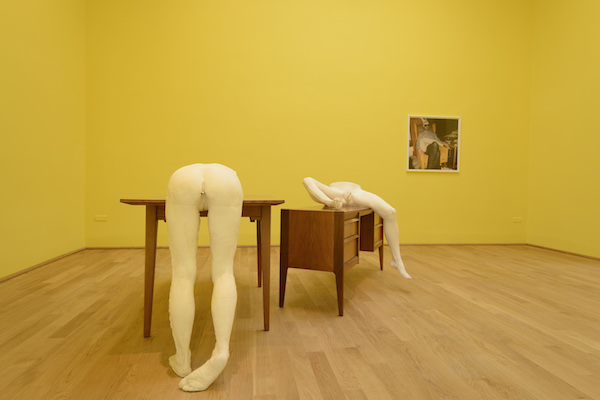
Sarah Lucas, I SCREAM DADDIO, Installation View, British Pavilion 2015
Photo: Cristiano Corte © British Council
Hirst has been conspicuously absent from the whole launch campaign of Newport Street Gallery. He hasn’t given any interviews and hasn’t attended the press views. “He really wants the art to do the talking and he didn’t want the focus to be on him but on John Hoyland,” Davies told artnet News.
It’s seems a rather utopian goal, seeing as everybody seems to be regarding Hoyland’s exhibition more or less as a collateral of Hirst’s unrelenting ambition. Whether he manages to make the transition from waning artist to successful museum entrepreneur in the long run remains to be seen. He certainly has the real estate and the funds to do so.
There are also rumored plans for an exhibition of new works by Hirst in 2017, although the artist and his team are keeping all details under wraps (let’s only hope he doesn’t have another go at self-made painting, as his two previous shows of paintings by his own hand were universally panned).

Damien Hirst posing with one of his Blue Paintings in 2009
Photo: via the Telegraph.
If Hirst manages to resuscitate his devalued artistic career and market with the help of his brand new museum and his long-held supporters, it will be yet another impressive coup for an artist that always knew how to make things happen for himself. His legacy certainly isn’t his sole concern, but a pressing issue for a number of A-list collectors, like Jose Mugrabi, who, according to the WSJ, has over 120 works by the British artist and who bought $33 million worth of art by Hirst just three months ago.
“Damien Hirst is in the same situation as Warhol was in the 1990s,” Mugrabi told WSJ. “I love Damien at $10,000, and I love him at $10 million. The price is secondary because I know people love him, and in the end they will pay for him.”
The die is cast.
John Hoyland, “Power Stations, Paintings 1964-1982” is on view at Newport Street Gallery, London, from October 8, 2015 – April 3, 2016.